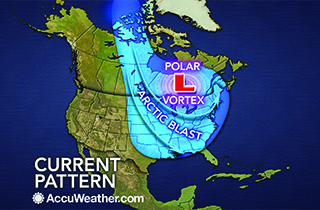Low Temperatures = High Electricity Use

January’s blast of extremely cold air—a sinking polar vortex—set new records in Kentucky and other parts of the eastern United States. Here’s how power grid operators and individual utilities managed their systems to respond to the challenge.
Normal peaks, periods of high demand for electricity, occur daily year-round in late afternoon and early evening. To meet these daily changes in demand, power plant operators adjust the flow of electricity up and down from their core group of generators.
During seasonal peaks, overall demand for electricity is high for several weeks or months in a row. To meet this extra demand, utilities turn on additional generating sources called peaking units. Summer peaks occur when the most air conditioners are running, changing indoor air temperatures by 20 or 30 degrees. Winter peaks occur when the most heating systems are running, changing indoor air temperatures by 50 or more degrees. As outdoor temperatures fall lower and lower, demand for electricity continues to increase.
Utilities within each region of the United States coordinate which winter peaking units are operating, then send extra power through transmission lines to areas with the highest demand.
In early January, with all available generators running near their highest output throughout many states and demand continuing to rise, regional transmission system managers asked local utilities to use two strategies to keep the power system in balance. Utilities stopped sending electricity to some customers who’d previously agreed to have their service interrupted. Utilities also asked the public to voluntarily reduce nonessential electricity use. These conservation efforts prevented disruptions to the power grid as demand reached all-time single day and overnight levels in many states.

